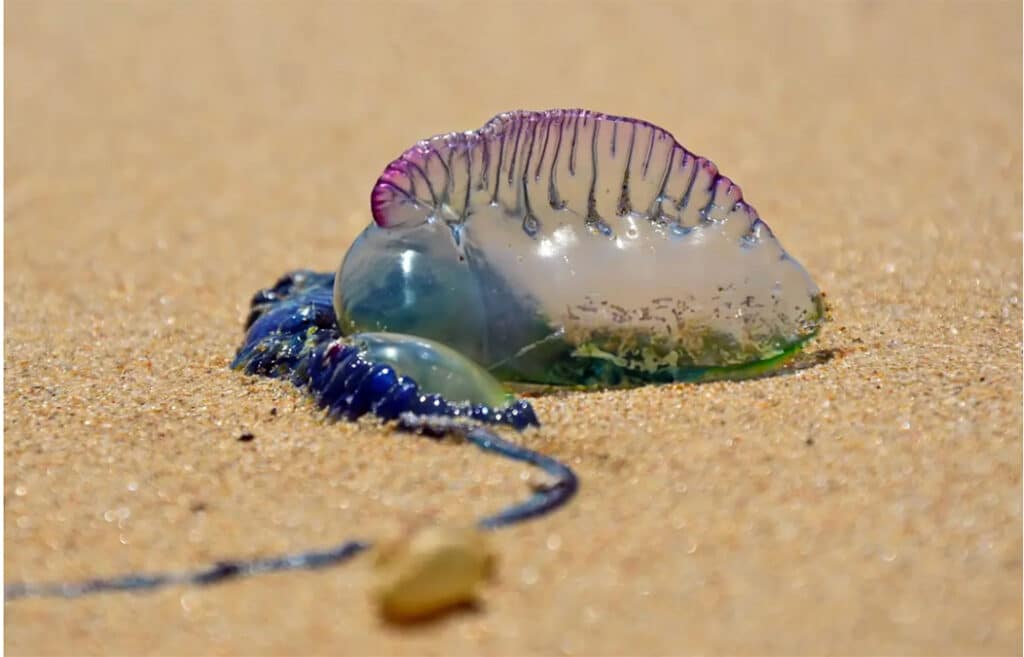by Dr. Sarah Treanor Bois, PhD
Director of Research & Education at the Linda Loring Nature Foundation
Last weekend, the first Portuguese Man-o-War of the season were spotted off of Cisco and Ladies Beaches. By the time this article is printed, I expect there will have been more sightings.
Known for its vibrant blue and pink colors, Portuguese Man-o-War has a gas filled bag on top with tentacles that can extend up to 30 feet in length. During the day, the Man-o-War tentacles coil up, and appear thicker and shorter, but when they fish for prey at night, the tentacles extend out further, difficult to avoid for a swimmer.
Counter to popular belief, Portuguese Man-o-War are actually not a jellyfish as all, but rather a siphonophore. A siphonophore is unusual in that it is comprised of a colony of specialized, genetically identical individuals called zooids (sort of like clones) with various forms and functions, all working together as one. According to NOAA (National Oceanic and Atmospheric Administration), “Each of the four specialized parts of a man o’ war is responsible for a specific task, such as floating, capturing prey, feeding, and reproduction.” The pneumatophore is the balloon-like structure that is visible above the water line. It is filled with atmospheric gasses, primarily carbon monoxide. The dactylozooids are tentacles filled with venom-filled nematocysts. They sting predators and capture prey. The gastrozooids are tentacles that digest food and nutrients coming into the organism. Lastly, the gonozooids are tentacles that serve a reproductive function. There is no propulsion device, such as fins, and the Man-o-War travel only by tides, currents, and winds. The pneumatophore (the balloon-like top part) can act like a small sail catching the breeze. This is why they are often found on the beach in the wrack line; they can’t really avoid the shore.
Their tentacles contain stinging microscopic capsules loaded with coiled, barbed tubes that deliver venom capable of paralyzing small fish and crustaceans. The sting isn’t deadly to people, but it packs a punch that can cause welts on exposed skin.
Portuguese Man-o-War are generally found in larger numbers further south. But they have a broad distribution and can be found in the Indian Ocean, the Pacific Ocean, the Atlantic Ocean, and even the Caribbean Sea. They typically live in tropical or subtropical climates in coastal and open-ocean environments. Occasionally, some colonies have even been observed in Irish and British coastal waters when they float on the currents or in the gusts of wind as far north as the Bay of Fundy in Canada. More sightings of the Portuguese Man-o-War in northern waters are anticipated as ocean warming continues.
On Nantucket, we typically have reports of a few each year, but the past couple of years we’ve seen greater numbers. Last year, several beaches were closed because of the “hazardous marine life” including Man-o-War and related jellyfish species.
Why so many all of a sudden? As ocean temperatures begin to rise on average due to global climate change, the Portuguese Man-o-War population has also begun to rise in number.
June 2023’s global average temperature was the hottest June on record and we’re on trend for 2023 to be the warmest on record. Similarly, our ocean waters are warming off New England at a faster rate than many other areas. With this warming comes changing patterns for marine species which are either seeking cooler waters or following changing ocean currents.
Rising ocean temperatures are coupled with reduced oxygen levels in the water. This combination, while detrimental to some, has created a suite of conditions where Portuguese Man-o-War can thrive. That, coupled with the south wind we recently had, brought the Man-o-Wars in to the south shore beaches of Nantucket. Based on their behavior last year, keep an eye out for warnings before headed to the beach. Beach conditions are posted daily by 11 am at the Insider’s Guide to Nantucket: Nantucket.net/beaches. And be aware that while the tentacles are more dangerous in the water (because they are more difficult to avoid) they can even fire when dead on the beach, so avoid them whenever possible.
Where the Man-o-War were found recently, the Town of Nantucket Harbormaster reported the beaches with purple flags on the daily beach report. Keep an eye out for the warning. Last year, some beaches were closed to swimming if the number of Man-o-War or jellyfish were in great abundance. If you do get stung, you should remove the tentacles immediately, and you can treat the sting with salt water and heat.
Having the Portuguese Man-o-War around isn’t all bad. Everything can be prey for something else. Its predators include the Loggerhead Turtle and Ocean Sunfish (or Mola mola), and crabs, among other species. Each of these predators has a specifically curated strategy for avoiding the threat of stinging tentacles so that it can capture the Portuguese Man-o-War as its own prey. For example, the Loggerhead Turtle’s skin is too thick for the nematocysts to puncture. We might not appreciate the Portuguese Man-o-War when hanging on the beach or swimming on a hot summer day, their numbers are increasing and at least they can be a food source for some of our local species.
As sea surface temperatures continue to rise more and earlier occurrences of Portuguese Man-o-War and related jellyfish species may be on the horizon.
